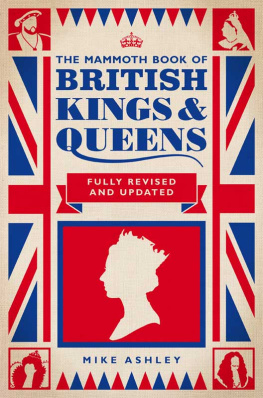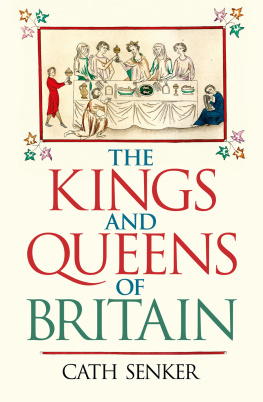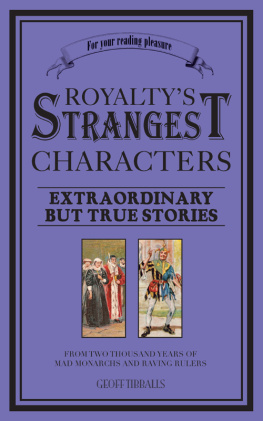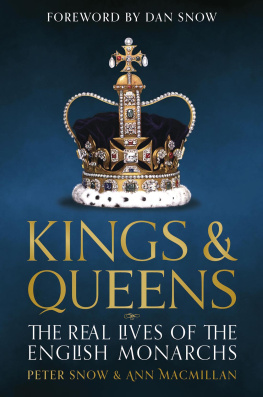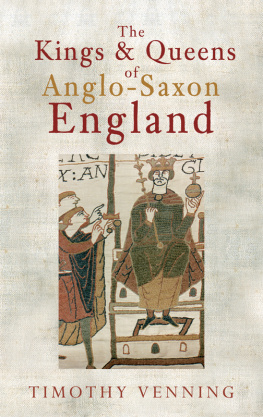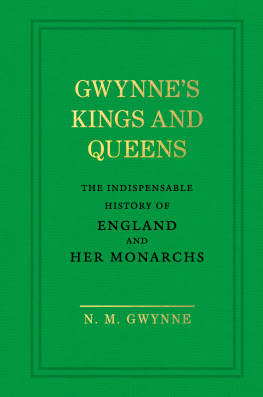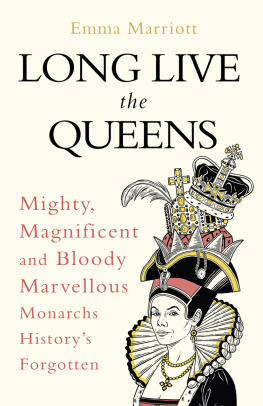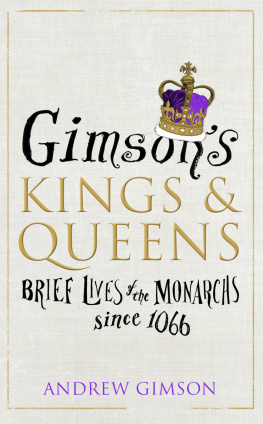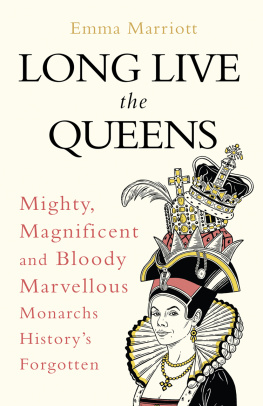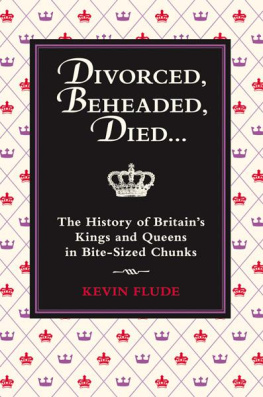The Mammoth Book of
BRITISH KINGS
& QUEENS
The Mammoth Book of
BRITISH KINGS
& QUEENS
Mike Ashley
ROBINSON
London
Constable & Robinson Ltd
5556 Russell Square
London WC1B 4HP
www.constablerobinson.com
First published in the UK as British Monarchs by Robinson Publishing 1998
This paperback edition 1999, reprinted 2000
Copyright Mike Ashley 1998
The moral right of the author has been asserted.
All rights reserved. This book is sold subject to the condition that it shall not, by any way of trade or otherwise, be lent, re-sold, hired out or otherwise circulated in any form of binding or cover other than that in which it is published and without a similiar condition including this condition being imposed upon the subsequent purchaser.
A copy of the British Library Cataloguing in Publication data is available from the British Library
ISBN 1841190969
eISBN: 9781472101136
Produced by Book Packaging and Marketing, Silverstone
Edited by Julian Lock
Designed by Adrian Hodgkins Design, Oxford
Illustrated by John Fuller
Charts and Maps by Brian Inness
Typeset by Joshua Horgan, Oxford
Printed and bound in the EC
CONTENTS
The Genealogical Tables (Charts)
The Dark Ages
The Fight for Britain
Uniting the Kingdom
The Maps
The Dark Ages
The Fight for Britain
INTRODUCTION
This book is the most complete record of the kings and queens of Britain ever compiled. It contains details on almost one thousand rulers from the earliest times to the present day.
It may come as a surprise to realize that there have been a thousand kings and queens in Britain. After all, there have only been forty-three rulers of England since 1066 when William the Conqueror defeated king Harold at Hastings. Where have the other nine hundred or so come from?
The United Kingdom has only existed for about three hundred years, since the Act of Union of 1707. Before that England and Scotland were separate kingdoms and, prior to 1603, with the accession of James VI of Scotland as James I of England the two kingdoms were ruled by different kings. In fact there have been more kings of Scotland than of England. Some of them are familiar to those of us who do not live in Scotland, especially Robert the Bruce and Macbeth. The kingdom dates back to around AD 500, when Fergus established himself as lord of the Irish settlers in Kintyre and Argyll. This territory became known as Dl Riata. The settlers were known as the Scots but the real masters of northern Britain were the Picts who had their own kings. The raids of the Vikings brought them closer together and allowed the Scots the upper hand. Even then, although Scotland gradually emerged as one kingdom, the descendants of the Picts remained vehemently independent as the Highlanders who looked to their own rulers, first amongst the men of Moray and then the Kings of the Isles.
Wales also had its own kings and princes before Edward I brought an end to their independence in 1284. Wales was in fact a conglomeration of kingdoms with no political unity but some of these kingdoms, particularly Gwent, have a line of kings that go back before the Roman conquest to the earliest known British kings and queens. The earliest king covered in this book is Beli the Great who ruled at the start of the first century BC. Others from that period that we are likely to know include Boudica or Boadicea, Cymbeline or Cunobelin and Caratacus.
Prior to the Norman conquest England had striven for unity under the Saxons. There had originally been seven main Saxon kingdoms, called the heptarchy, of which Wessex, Mercia and Northumbria were the strongest. All had their major kings who had an influence upon the whole of Britain. It was thanks to Oswy of Northumbria that we adopted the practices of the Church of Rome rather than the Celtic church. Under Offa of Mercia, England became a European force for the first time and almost a united kingdom. Under Alfred of Wessex, Alfred the Great as we know him, the Saxons managed to drive back the Danes. We tend to forget that the Danes won in the end. Canute of Denmark ruled England almost a thousand years ago, and William of Normandy was himself descended from the Vikings. The Norse had a hold over parts of Britain until the fifteenth century, where there were separate earldoms and kingdoms of the Orkneys, the Hebrides and the Isle of Man.
Before the Saxons invaded Britain during the fifth century, and after Roman administration collapsed, Britain reverted to some of its native kings. This was the mysterious time of King Arthur and of Old King Cole or Coel to give him his proper name. He really did exist.
Perhaps that gives some idea of where these thousand rulers come from. Some may be no more than names to us, lost in legend, but in many cases they existed and this book sets them in their historical context and shows what contribution they made to the development of Britain.
This book is divided into four main sections.
1. The Royal Book of Records. Here you will find the answers to such questions as who had the shortest reign, or who lived the longest? This section will introduce you to many familiar names but also a surprising number of less familiar ones.
2. The Kingdoms of Britain. This provides a historical introduction which traces the history of all of the different kingdoms of Britain. The time chart allows you to follow the development of each kingdom and show how they gradually merged to form the United Kingdom as we know it today.
3. The Kings and Queens of Britain. This is the largest part of the book and has biographical entries on every known ruler. To make it easy to use the section is divided into each separate kingdom. For each kingdom there is a map, to show you where that kingdom existed; a succession list, which shows you the sequence of rulers at a glance; and a family tree, which shows you the relationships between the rulers. The biographical entries follow in chronological order so that you can trace the history of each kingdom. Every ruler has a unique reference number shown in brackets before their name (e.g. [G5]) and that number is used throughout in cross-reference elsewhere (in the tables, family trees and index) to keep track of each name. A few people who were not rulers in their own right, but who claimed regal status, are accorded entries and are inserted in boxed form in their right sequence. This applies to certain pretenders or claimants to the throne such as Perkin Warbeck or Bonnie Prince Charlie.
This section is also split into four main parts which help follow through the chronological sequence. The first part is called The Dark Ages and covers all of the rulers from the earliest mists of time to the point when more established kingdoms in England, Wales and Scotland began to emerge in the tenth century.
The second part is The Fight for Britain. This takes us from the tenth century through to the emergence of England as the dominant power at the time of Edward I. It traces the fight for supremacy from the time of the Danish and Norman conquests through to the English domination of the Welsh princes, and the almost total subjugation of Scotland until its revival under Robert the Bruce.
The third part is The United Kingdom. This follows the lives of the kings from Edward I of England and Robert the Bruce of Scotland down through the amalgamation of England and Scotland at the time of James VI/I, the Civil War and the restoration of the monarchy under Charles II to the modern day, when the institution of the monarchy is again under threat.

